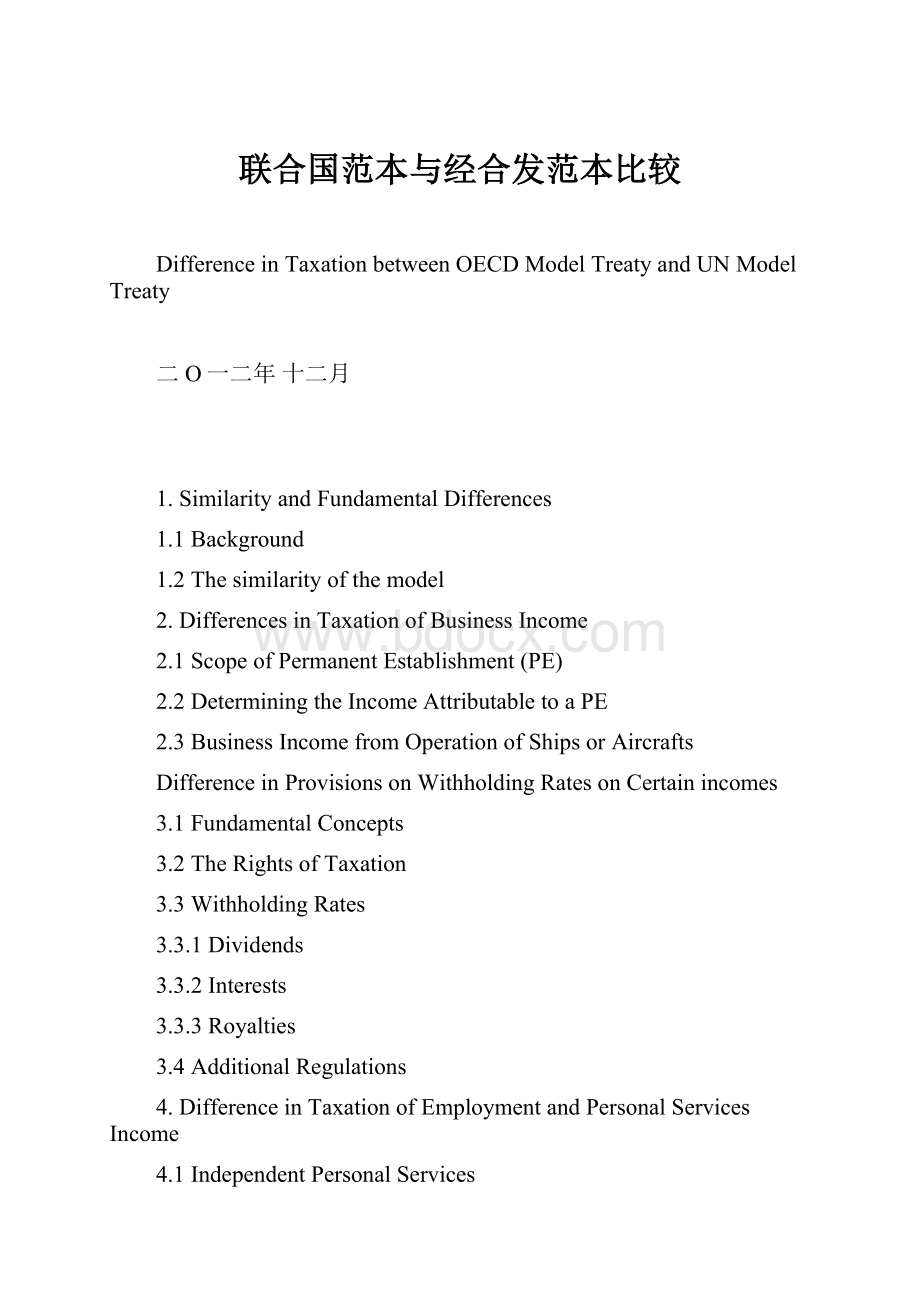联合国范本与经合发范本比较.docx
《联合国范本与经合发范本比较.docx》由会员分享,可在线阅读,更多相关《联合国范本与经合发范本比较.docx(15页珍藏版)》请在冰豆网上搜索。

联合国范本与经合发范本比较
DifferenceinTaxationbetweenOECDModelTreatyandUNModelTreaty
二O一二年十二月
1.SimilarityandFundamentalDifferences
1.1Background
1.2Thesimilarityofthemodel
2.DifferencesinTaxationofBusinessIncome
2.1ScopeofPermanentEstablishment(PE)
2.2DeterminingtheIncomeAttributabletoaPE
2.3BusinessIncomefromOperationofShipsorAircrafts
DifferenceinProvisionsonWithholdingRatesonCertainincomes
3.1FundamentalConcepts
3.2TheRightsofTaxation
3.3WithholdingRates
3.3.1Dividends
3.3.2Interests
3.3.3Royalties
3.4AdditionalRegulations
4.DifferenceinTaxationofEmploymentandPersonalServicesIncome
4.1IndependentPersonalServices
4.2Directors’Fees&ArtistesandSportspersons
4.3Pensions(underArticle18)
4.4Students(underArticle20)
Othertypesofincome
6.Exchangeofinformation
7.Trendforecast
Abstract
OurdiscussionofdifferencebetweenOECDModelTreatyandUNModelTreatyisdividedinsevenparts.Thefirstpartbrieflyexplainssimilaritiesandfundamentaldifferencesbetweenthesetwotreaties;thesecondpartexplainsindetailsdifferenceintaxationofbusinessincome,whichisfurtherintroducedinthefollowingthreedimensions,scopeofpermanentestablishment,determiningtheincomeattributabletoaPEandbusinessincomefromoperationofshipsoraircrafts;thethirdpartisaboutdifferencebetweenthetwotreatiesinprovisionsofwithholdingratesoncertaininvestmentincome,mainlyincludingdividends,interestsandroyalties;thefourthpartintroducesdifferenceintaxationofemploymentandpersonalservicesincomeinfollowingfouraspects,thatis,independentpersonalservices,directors’fees,pensionsandstudents;thefifthpartisaboutdifferenceintaxationofothertypesofincome;thesixthpartintroducesdifferenceofprovisionsofinformationexchangebetweenthetwotreaties;thelastpartisabriefdescriptionoftrendofrelationshipbetweenthesetwotreaties.Ingeneral,thesetwotreatiesarecongruousinmostprovisions;thisarticleshedsomelightondifferencebetweenthesetwotreaties,thuscausingattentiontothistopicwhentaxationiscalculatedinreallife.
【KeyWords】OECDModelTreaty,UNModelTreaty,taxation,difference,businessincome,withholdingrates,personalincome,informationexchange
1.SimilarityandFundamentalDifferences
1.1Background
Asinternationalcommunicationbecomesmoreandmorefrequentinthedailylife,internationaltaxproblemsareincreasing.Theexistingtaxlawsareoutofstepswithtimes.Ifwedidn’tmakechanges,wewouldfacemoreproblems.Therefore,it’snecessaryforthecountriestoconcludeagreementsofinternationaltaxinordertocoordinatethetaxrevenues.Onlyinthisway,canthesecountriesfurtherdevelop.
Nowadays,thetaxtreatiesrepresentanimportantaspectoftheinternationaltaxrulesofmostcountries.Over2000bilateralincometaxtreatiesarecurrentlyineffect,andthenumberisgrowing.TheoverwhelmingmajorityofthesetreatiesarebasedinlargepartintheOECDModelTreaty.TheUNModelTreatyissubstantiallysimilartotheOECDModelTreatybutincludessomeprovisionsthatarenotincludesintheOECDModelTreaty.
Wearegoingtodiscussthesimilaritiesanddifferencesbetweenthesetwotreatiesinordertounderstandhowthesetwotreatiesinteractandintersect.It’sveryusefulforustorealizethebasicsituationandthedevelopmentprospectoftheinternationaltax.
Now,wewillintroducethesimilaritiesandfundamentaldifferences.
1.2Thesimilarityofthemodel
Theremarkablesimilaritiesofthetwotreatiesaretheobjectivesontaxtreaties.Theobjectiveoftaxtreaties,broadlystated,istofacilitatecross-bordertradeandinvestmentbyeliminatingthetaximpedimentstothesecross-borderflows.Thisbroadobjectiveissupplementedbyseveralmorespecific,operationalobjectives.Themostimportantoperationalobjectiveofbilateralistheeliminationofdoubletaxation.Mostofthesubstantiveprovisionsofthetypicaltaxtreatyaredirectedattheachievementsofthisgoal.Forexample,taxtreatiescontaintie-breakerrulestomakeataxpayerwhoisotherwiseresidenceinbothcountriesaresidentinonlyoneofthecountry.Theyalsolimitoreliminatethesourcecountrytaxoncertaintypesofincomeandrequireresidencecountriestoprovidereliefforsourcecountrytaxes.
Thehistoricalemphasisintheeliminationofthedoubletaxationshouldnotobscurethefactthatmosttaxtreatieshaveanotherequallyimportantoperationalobjective-thepreventioniffiscalevasion.Thisobjectivecounterbalancestheeliminationofdoubletaxation.Justasdoubletaxationimposesaninappropriatebarriertointernationalcommerce,thetoleranceoffiscalevasionoffersaninappropriateincentivetosuchcommerce.
Inadditiontothetwoprincipaloperationalobjectivesoftaxtreaties,thereareseveralancillaryobjectives.Oneancillaryobjectiveistheeliminationofdiscriminationagainstforeignnationalsandnonresidents.AsecondancillaryobjectiveistheexchangeofinformationbetweentheContractingStates.Theexchangeifinformationcanbeanimportanttoolincombatingfiscalevasion.Andalso,bothofthetreatiescanprovidecertaintyfortaxpayers.
Beyondthat,thestructureoftheOECEandUNisthesame.Theyallincludetitleandpreface.Chapter1-2ofbothtreatiesissomeconceptualproblemssuchasthedefinitionsofsomespecificwords.Chapter3-6isaboutconcreteproblemsuchasincometax,propertytax,doubletaxationreliefandsomespecialregulations.Chapter7includessomefinalrulesandthecomplimentaryclose.
Alloftheabovearethesimilaritiesofthetwomodels.Inthefollowingpart,wewilltalkaboutsomefundamentaldifferencesbetweenthetwomodels.
1.3Fundamentaldifferencesbetweenthetwomodels
ThechiefdifferencebetweenthetwomodelsisthattheUNmodelimposesfewerrestrictionsonthetaxjurisdictionsofthesourcecountries,whiletheOECDmodeldoesnot.
TheOECDModelTreatyfavorscapitalexportingcountriesovercapitalimportingcountries.Ofteniteliminatesormitigatesdoubletaxationbyrequiringthesourcecountriestogiveupsomeorallofitstaxoncertaincategoriesofincomeearnedbyresidencesoftheothertreatycountry.ThereforetheOECDModelTreatyisunfavorableforacountrythatidanetimporterofcapital.However,theimportersofcapitalarealwaysdevelopingcountries.TheOECDModelputmuchemphasisonthebenefitsofcapitalexportingcountriessuchastheUnitedStatesandtheUnitedKingdom.Thereasonisthatthosecountriesaredevelopedcountries.Onthecontrary,theUNModelconsidersissuesintheperspectiveofdevelopedcountries’interestsandneeds,whichcanbeappliedtothetaxaffairsbetweenthedevelopedanddevelopingcountriesaswellastheinternationalinvestmentactivities.Fromtheaboveanalysis,wecaneasilyconcludethattheOCEDmodelmainlyfocusontheresidencejurisdiction,whichputemphasisonthebenefitsofdevelopedcountries.WhenitcomestotheUNmodel,itfocusesonthesourcejurisdictionandthebenefitsofdevelopingcountries.
InordertocorrecttheflawsoftheOECDModelTreaty,theUNModelTreatycameintobeing.Forexample,theUNModelTreatydoesnotcontainspecificlimitationsonthewithholdingtaxrateondividends,interest,androyaltiesimposedbythesourcecounty;instead,thewithholdingratelevelsarelefttobilateralnegotiationsbetweentheContractingStates.
2.Differencesintaxationofbusinessincome
Taxationofbusinessincomeininternationaltreatiesincludesthreeparts.Theyareordinarybusinessincome,businessIncomefromoperationofshipsoraircrafts,businessincomefromassociatedenterprise.
2.1ScopeofPermanentEstablishment(PE)
Permanentestablishmentisafundamentalandcrucialconceptininternationaltreatiesanditisthebasisfortaxationofbusinessincome.UnderArticle5oftheOECDandUNModelTreaties,aPEgenerallyis“afixedplaceofbusinessthroughwhichthebusinessofanenterpriseiswhollyorpartlycarriedon.”thislanguageisusedinanessentiallyidenticalforminalmostalltaxtreaties.Sourcecountriescanonlytaxbusinessincomeifitisderivedfrompermanentestablishment;otherwise,sourcecountrycannottaxanyincomenomatterhowmuchprofitisgenerated.Forthismatter,thescopeofpermanentestablishmenthasalwaysbeenthekeyissueininternationaltreaties.Itcanbecomparedtoabridgeconnectingsourcecountriesandresidentcountries.Partorallofincomenottaxedbysourcecountriesmaybetransferredtoresidentcountries.Ifbothsidesdoesn’ttaxthisincome,thenthetaxpayeractuallyenjoysataxationexemption.Thisleadstoagaintoresidentcountriesatthecostofalossofsourcecountries.
(1)Minimumperiod(page195)
AsisstatedinArticle5,(3)OECD,abuildingsite,drillingoperation,orothertemporaryprojectlocationconstitutesaPEiftheprojectcontinuesforatleastoneyear,whiletheUNModelTreatyusesaminimumperiodof6months.Andsometreatiesbetweendevelopingcountryanddevelopedcountryrequiresanevenshorterperiod,forexample,theminimumperiodinIndia-UnitedStatestreatyis4months.Thisdiscrepancyshouldnotbeoverlookedbecausealotofbuildingactivitiescanbefinishedwithin6months,thusavoidingbeingtaxedaccordingtoUNModel.Thiswouldcauseagreatlossoftaxationtosourcecountries(usuallydevelopingcountries)onthebasisofOECDModel.
(2)ActivitiesCoveredbytheFormerProvision(page197)
Article5,(3)UNdefinesanassemblylineandsupervisoryactivitiesconductedinconnectionwithabuilding